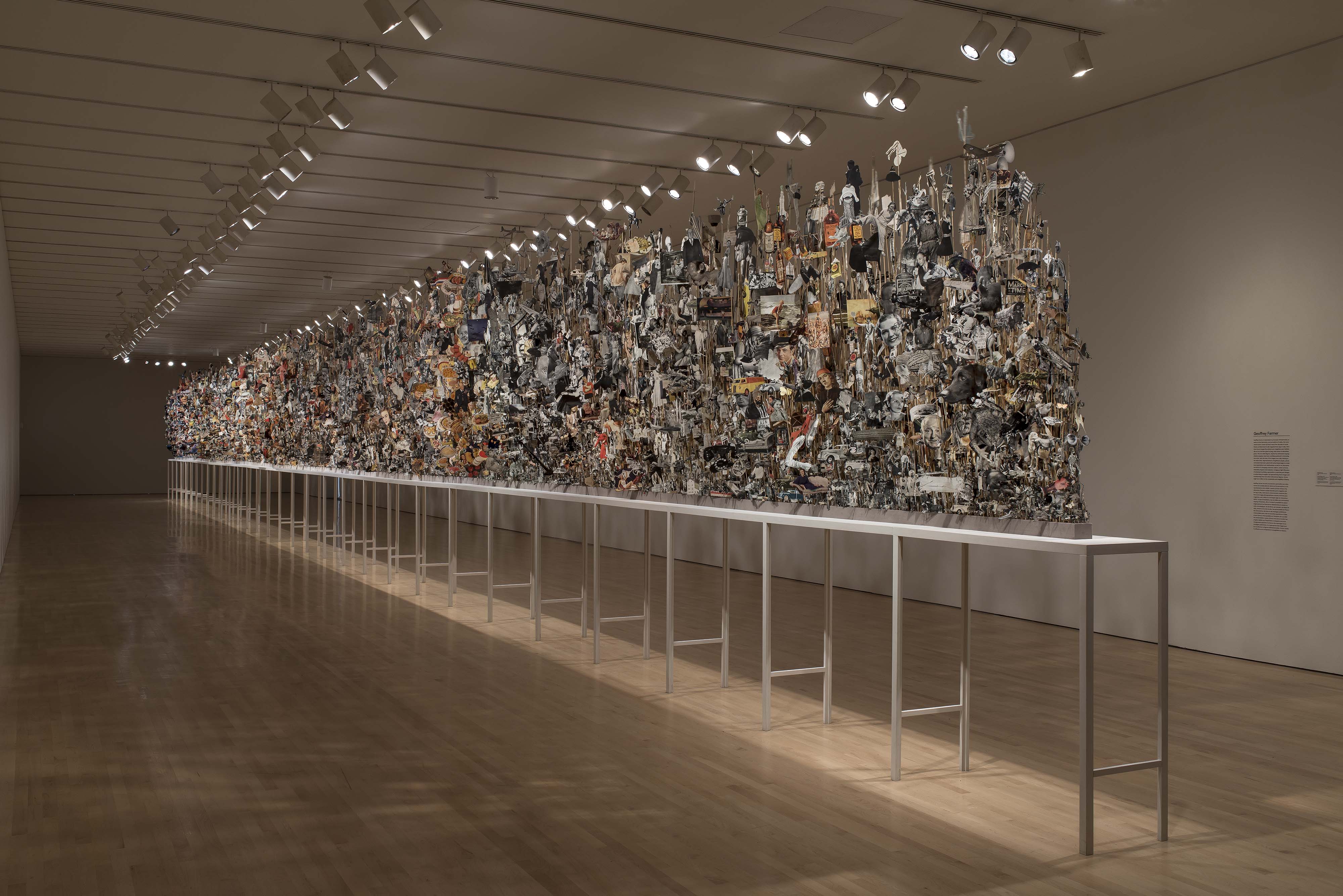
Geoffrey Farmer. Leaves of Grass, 2012. Cut-out images from Life magazines, archival glue, miscanthus grass, floral foam and wooden table; installation dimensions variable.
I step behind the podium, my back to the window. A car whizzes past as an even louder one approaches—a truck? I am about to thank the person who had just introduced me, but for some reason I turn to the window, and I see that the louder vehicle is not a truck but a mid-’80s compact with a shot muffler. The hiss from my snicker gets picked up by the microphone; it sounds like the first car.
It is a warm September evening just after Labor Day, and we are gathered at Jane Irwin and Ross Hill’s GreyChurch project space in Vancouver, to honor the artist Geoffrey Farmer, Canada’s entry in the 57th Venice Biennale. As most of the one-hundred-plus in attendance know, this is a fundraiser, for Vancouver is one of the three Canadian cities that the National Gallery of Canada visits to raise money for its biennial Venice presence. Because we are in Vancouver, and because Farmer is a well-liked and highly respected Vancouver artist, the money will come easily. But because it is Farmer, the event will function less as a cocktail party than as a sensorium. At least that is the artist’s intention.
What Farmer had in mind included audio and visual interventions by artists and, if I was willing, a reading of some poems by some poets he admires. Those familiar with Farmer’s monumental Documenta 13 installation, Leaves of Grass, will recall the poet Walt Whitman, whose 1855 book provided the installation with its title. Other poets we discussed were those in Donald Allen’s groundbreaking anthology, New American Poetry 1945–1960, such as John Ashbery, Allen Ginsberg, Barbara Guest, and Frank O’Hara. But the poetry Farmer most wanted to hear that night is the work of Peter Culley (1958–2015), a local who, like Ashbery and Frank O’Hara, wrote on the visual arts. These would be the poets on Farmer’s bill, but he left it to me to make a reading of their writing.
Vancouver art is noted for a long intermedial history, in which artists and writers did not so much converse with each other as explore each other’s mediums. Roy Kiyooka came to Vancouver from Saskatchewan in the late 1950s as a hard-edge painter, only to distinguish himself as a poet and correspondent. The painter Michael Morris traveled to England in 1964 and returned two years later with a portfolio of concrete poems. Judith Copithorne wrote poems while studying calligraphy and combined the two to produce expressive figurative texts. And the list continues, with variants like hard-bop pianist Al Neil, who left modal music in the early 1960s for jetsam assemblages and improvisational spoken-word performances, and the poet Gerry Gilbert, who applied lyrical principles to 35mm photography and 8mm film.
Farmer is aware of this history, which is present in his work, though it is not immediately visible, so I chose the poems carefully: Ashbery’s “The Instruction Manual,” Ginsberg’s “A Supermarket in California,” Barbara Guest’s “Parachutes, My Love, Could Carry Us Higher,” and Frank O’Hara’s “Why I Am Not a Painter.” As for Culley, he too was aware of the local history, and I built my reading around one of his earliest poems. Like Farmer’s Leaves of Grass (2012), a work occupying a long hallway and made up of collaged cutouts from Life magazines, Culley’s 1986 “Fruit Dots” is a similarly composed long poem that was sourced entirely from a nineteenth-century botany text.
But at fundraiser events, there are often glitches, delays, and unscheduled speeches. By the time I was introduced, I had to shorten my program to allow time for Farmer, who closed the evening with a breathlessly emotional tribute to the Italian factory that is helping him to convert the Canadian pavilion into a fountain garden. As with Vancouver’s historic multidisciplinary artists, Farmer is as interested in the way things are made as he is in their outcome. He focused his presentation less on the factory’s architecture and its tools and more on the people who arrive in the morning and who leave eight hours later, proud of their work, especially of the collaborative and supportive manner in which that work is made.